
Michael Collins received the honor from NAA president and CEO Greg Principato. Julie Boatman
The National Aeronautic Association presented astronaut and former Smithsonian National Air & Space Museum director Michael Collins (Major General, USAF, Retired) with the Wright Brothers Memorial Trophy at a gala dinner hosted by the Washington Aero Club in Washington, D.C., on Friday, December 13, 2019.
The trophy, established in 1948, honors the memory of the Wrights, Orville and Wilbur, by recognizing a living member of the aviation community who has contributed “significant public service of enduring value to aviation in the United States,” as Greg Principato, president and CEO of NAA, emphasized during his remarks at the event.
Collins opened his acceptance remarks with humor: “The youngest man in an Army family, I followed to West Point my father, my uncle and my brother, who had seven stars between them. When they weren’t looking, I sneaked off into the air force.” “I was an avid airplane… model builder, as was Neil Armstrong. When I wanted to improve my designs, I beefed up the fuselage so I could wind up the rubber band a little bit tighter. Neil would build a wind tunnel… a harbinger of things to come.”
Collins went to Edwards Air Force Base in 1959 to join the Air Force Aerospace Research Pilot School as a test pilot, which launched his quest to become an astronaut. He related how he put in his application in the second round, and was not selected and tried again a year later, to be with the third round, “the so-called Apollo 14 group,” in 1963. Collins credits the entire NASA team with the success that Apollo 11 so famously had. “We were able to land on the moon because we had the finest preparation, of Apollos 7, 8, 9 and 10. They did everything we did except make an actual landing.”
Collins, however, has been more than a lunar-mission astronaut—his recognition by the NAA was founded at least as much on his efforts to bring the National Air & Space Museum to fruition, both as its first director, but also securing the political will through actual appropriations to get the museum funded. The U.S. Congress had endorsed the creation of a “National Air Museum” in 1946, but had not allocated the funds to build it. Collins lobbied tirelessly for those funds in order to make the proposed opening date of July 4, 1976, the nation’s bicentennial. Under his leadership, the museum opened on July 1 that year, beating the deadline. The museum hosted one million visitors in the first month, and 10 million in the first year, and has consistently been among the most popular attractions in Washington, D.C. ever since.

Sign-up for newsletters & special offers!
Get the latest FLYING stories & special offers delivered directly to your inbox






